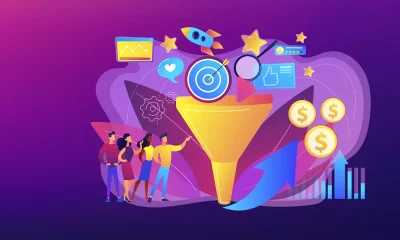Marketing
Digital Personalisation In An Ever-changing Environment

Organizations are placing a lot more emphasis on the ‘customer experience’ than ever before now. Digital personalization is the norm but it comes with some hooks for marketers and sites.
Customers expect you to know their preferences, for example, what they want, and who they are as individuals. However capturing customer data may seem simple enough, except there’s just a lot of it to do.
When you consider all the digital channels including social media where your customers interact with your brand – you need to be across all of them like an octopus. This activity is a recipe for complexity which requires a plan and system for expert management, plus technology.
The more you know about your customers, the more tailored your interaction with them. Not all your offerings will be presented only those that are relevant. More personalized communication and engagement will lead to a higher conversion rate.
Marketers with the goal of digital personalization can create workstreams and campaigns that engage with consumers to achieve greater rewards in an environment that are now using Big Data and AI and in particular auto-learning in marketing.
Therefore using software and platforms that make the customer data capture easy empowers marketers to focus on what information they’re capturing and how to dig deeper to uncover more usual metrics for higher-value marketing campaigns.
Digital Personalised Customer Data
How well do you know your targeted audience, including your customers?
This is an area many businesses believe they’re doing well in, but in reality, they’re just not capturing enough usable data. Do you charge your customers’ characteristics, behaviors, and attitudes?
Surveys
Attitudes are where most companies fall over, and the process can start with short surveys that incentivize as gathering this kind of data is crucial. Also, utilizing all of the touchpoints you have to gather analytics is one of the best ways to harness more data and slowly discern what digital marketing persona questions you should be asking.
Instead of monitoring simple analytics like open rate and click-through, use your digital channels to run specifically designed AB testing. In addition, look at implementing psychographic surveys to better understand your digital touchpoints.
Design your surveys to test customer attitudes towards your brand and their experience. Gathering these types of insights about your customers will allow you to move forward into the next stage of personalization, customer segmentation.
Segmenting Your Customer Base
Your organization can gather all of the data about your customers it wants, but if you do nothing with it, then what was the point? Once you have crafted a 360-degree view of your customer, including understanding who they are, what they do, why they do it, and how it makes them feel, you need to bring this to life in a segmentation model.
Customer segmentation is a means of clustering customers based on key behaviors and attitudes as opposed to gender, age or occupation which is not considered personalized, but simply grouping people together who look the same.
By utilizing behavioral and attitudinal data, you are presented with a customer segmentation model that clusters customers together by the need they are trying to satisfy.
Once you understand the need a specific segment is trying to satisfy, you can change the face of your experience offering entirely. For example, an energy customer whose market is to “set and forget” doesn’t want to be hit with banner advertising about solar panels. That experience is essential, but it demonstrates the exact opposite of personalization.
By understanding the customers’ needs, you can target their digital experience to include messaging such as “quick, hassle-free energy accounts”. Customer segmentation makes this personalization possible, but it won’t do the entire job.
A segmentation model is only as good as its implementation across all channels.
Channel Implementation
Successful implementation of your segmentation model relies on several factors, and arguably none more important than integration with your digital channels.
Customer Tagging
The best way to achieve this level of integration is through customer tagging. Depending on how you currently track your customers across your channels will provide the best way to tag. For example, if customer emails are used as a unique identifier, then tagging customer segments by email will allow you to adapt and modify content, offerings or sales when a customer hits on your digital channel.
Additionally, once you have successfully tagged your customers into their segments, actioning these segments in all of your digital communications and imagery is critical.
Once you understand how to motivate your customer segments, changing copy, images, and the overall look and feel of your
CRM communications is a quick way to achieve genuine personalisation beyond the inclusion of a first name. The beauty of segmentation in improving your digital personalization is that most of the time, customers don’t even realize what you have done.
Automated Learning
Learning about your customer’s attitudes and motivations, developing a segmentation model, and implementing the actionable insights across your channels is a huge step in the right direction.
To cap off your journey towards digital personalization, the final stage is implementing machine learning. Whether you opt for a marketing automation platform or develop a series of continuous validation processes, the need to continue to learn about your customers will be crucial to personalization in the long run.
A marketing automation platform allows machine learning to continue to test and identify any notable changes in customer behavior. For example, if a customer’s buying behavior suddenly changes, this triggers the machine to indicate a need for understanding.
Having already mapped the segments in your platform, the machine can determine whether a customer has shifted their segment over time. If they have, the platform can manage communications and experience accordingly. This kind of automation in the digital experience is the key to achieving genuine personalization and loyalty.
Digital personalization is a tricky target to hit. Whether your organization has the ability, systems, and resources to appropriately prioritize digital personalization is only one of the battles to face.
Customer and marketplaces as a whole are rapidly changing, and so too are expectations. The best way to combat this increased uncertainty in expectations is through detailed research, segmentation, and a continuous learning cycle. All of these areas of work require deep thought to genuinely meet your target of digital personalisation and a higher rate of conversion.









